Share the post "Soccer Position Numbers (Each Explained)"
There are reasons behind squad numbers, their origin, and why particular numbers hold a certain prestige.
Here’s a look at where soccer numbering systems originated and their role in organizing soccer positions: their formations and relevance in the modern game.
Understanding all the player’s positions, responsibilities, and roles is essential for every fan, player, and coach – you’ll be glad to know.
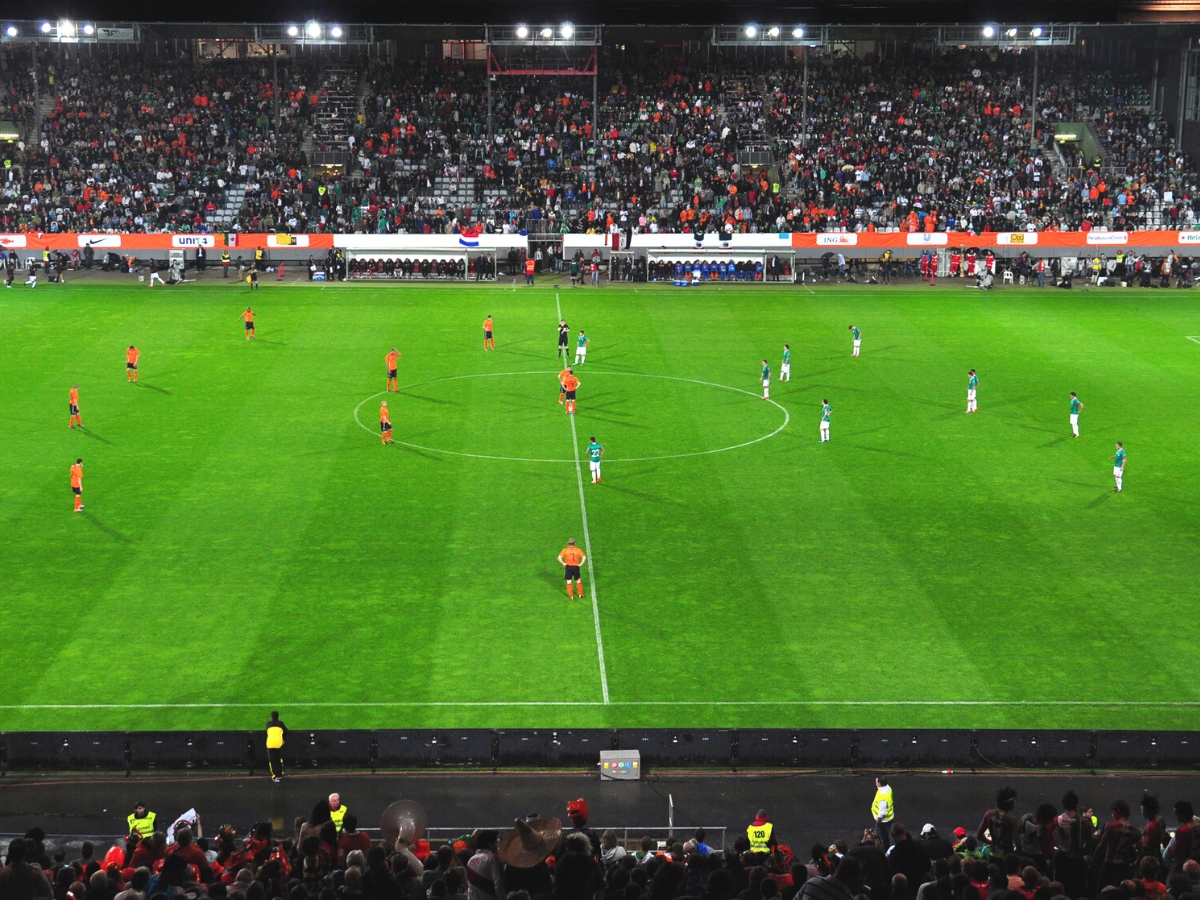
Soccer numbering systems and positions
- Goalkeeper – GK
- Right Full-Back – RB
- Left Full-Back – LB
- Center-Back – CB
- Center-Back – CB
- Center Midfield – CM
- Right Midfield – RM
- Center Midfield – CM
- Striker – ST
- Center Forward – CF
- Left Midfield – LM
This is the traditional numbering system for soccer’s first eleven players based on a 4-4-2 system. Later on, we’ll look at the many variations of formations.
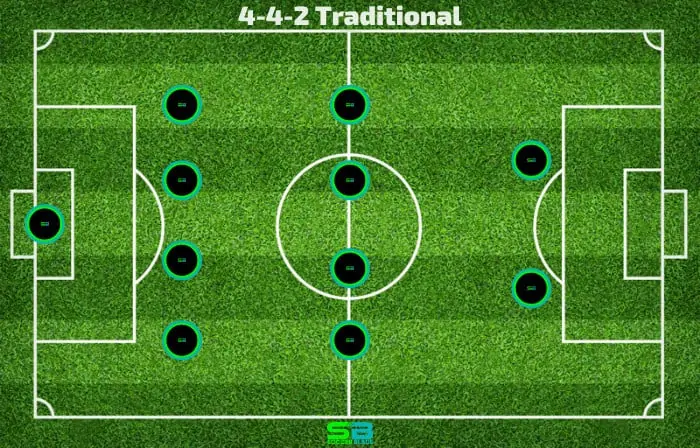
A player’s squad number plays a significant role in modern soccer. There can be great esteem held to a number. There are ‘iconic’ numbers that are widely associated with some of the sport’s greatest heroes.
Teams have a large squad of players, and each is assigned a ‘squad number’. Player squad numbers range from 1 to 99.
In the past, if a player were substituted after replacing a player, they would wear the same number so that the team contains 1 to 11.
First, let’s take a quick look at the history of soccer numbering systems to understand how they’ve developed over the years and where we are today.
Some franchises have a deep association with specific numbers. Take Manchester United, for example. Throughout their revered history, the number 7 has been brandished by some of the team’s most loved figures:
Cristiano Ronaldo, Eric Cantona, David Beckham, George Best. It’s a great honor to wear the number 7 shirt for Manchester United.
The same can be said for different numbers in other franchises. Generally, the standard-bearers for significant squad numbers are 1, 10, 7, and 9.
Even in kids’ games, players rush for these numbers when the uniforms are being divided. Every young player wants to emulate their hero.
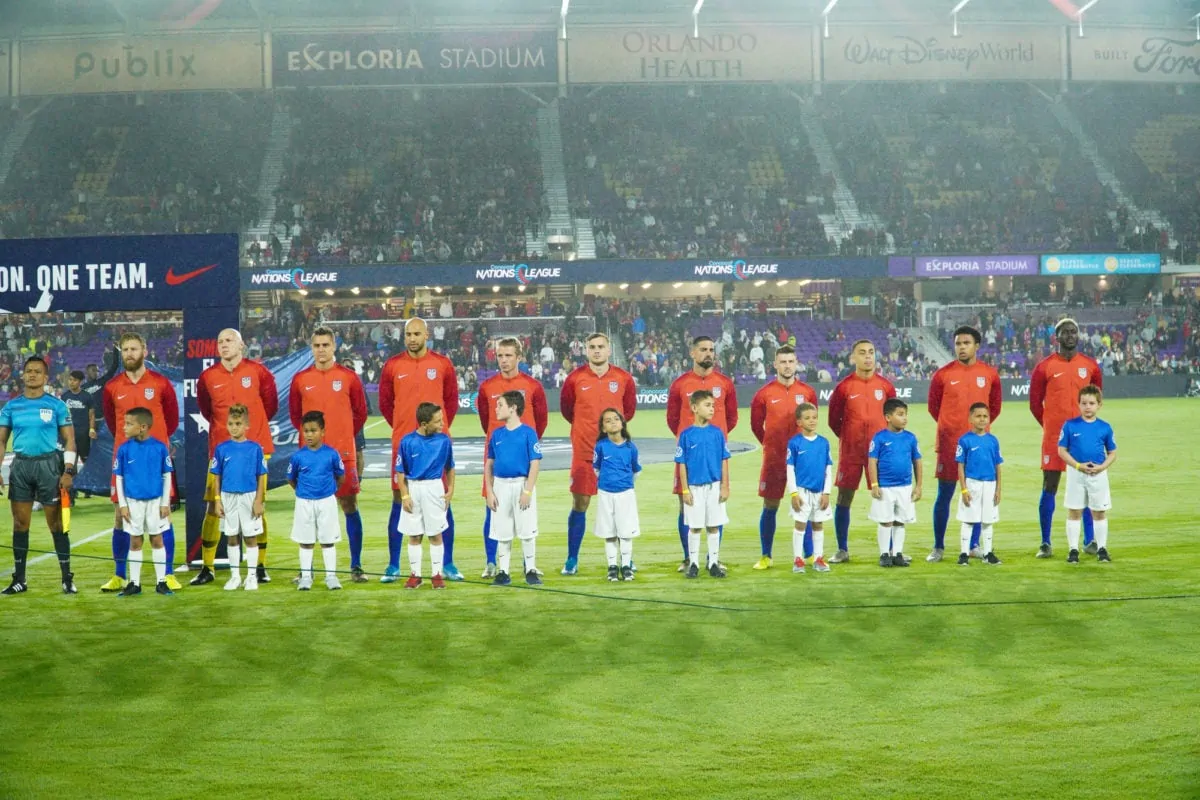
When Soccer players started wearing numbers
The first time that numbers were used in European soccer was in 1928, when Arsenal manager Herbert Chapman decided to structure the formation of his team using squad numbers.
The formations of that era are in stark contrast to what we see today – almost opposite in ways.
In the early 1900s, most defenses consisted of 2 players. It wasn’t until the 1950s that it became normal to have 3+ defenders in a backline.
As you can probably tell, the names of these positions are still used today. However, the literal meaning of the positions makes more sense when referring to the older formation style.
History of Soccer Positions Names and Numbers
Have you ever wondered why right and left backs are referred to as full-backs? Right, and left-backs were the original center backs – confusing, yeah no wonder they changed it!
Over time, the ‘half-backs’ dropped deeper into defense, pushing the full-backs into wider positions.
Players would move around a lot within this type of formation. A center half-back (#5) would often slot in as a defender, taking the number 5 with him/her.
The number 5 is widely associated with the modern center-back position, which is still commonly referred to as ‘center-half’. We regularly see defenders and midfielders wearing #4 or #6.
- There is no standard for formations these days but the core positions in the game come from a 4-4-2 style setup.
Although the numbering systems of soccer did not originate from this formation.
We’ve grown accustomed to certain positions being linked to each number. Therefore, this article will cover numbering systems in soccer-based out of the 4-4-2 formation.
Soccer Numbering Systems: Positions
#1 Goalkeeper – Keeper – Stopper (GK)
This position is often referred to as a goalie or ‘keeper. In Fifa tournaments, the number 1 must be the goalkeeper.
This is a unique position. A goalkeeper (GK) within the penalty box can touch or hold the ball with their hands/arms. No other player on the team can handle the ball on the field when the ball is in play.
The goalkeeper wears a different color kit to the outfield players. It’s usually padded, offering extra protection.
This is needed, as a GK experiences significant impacts when making saves. He/She also wears gloves for support and grip.
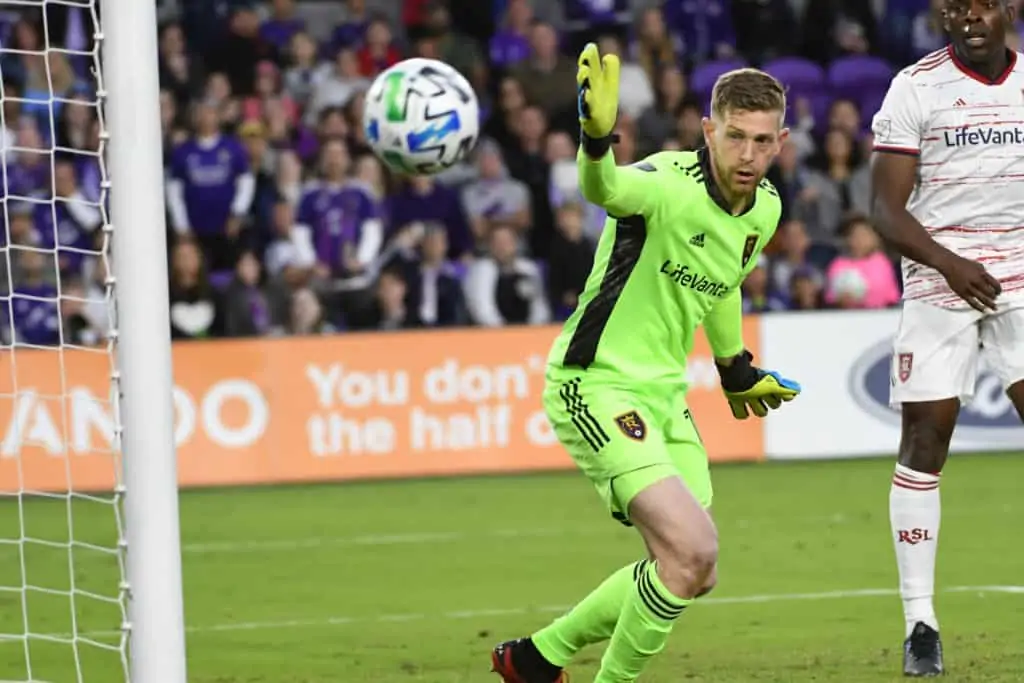
Goalkeeper’s Position, Role, and Responsibilities
The main role of a goalkeeper is to stop the opposition from scoring. They use whatever part of their body to block shots from going in.
In most circumstances, a goalkeeper is responsible for taking goal-kicks/kick-outs (when the opposition plays the ball out over the end-line).
As the last line of defense and with a clear view of the entire field, the goalkeeper plays a pivotal role in the organization and positioning of the outfield players, barking out instructions from their box.
#2 Right Full-Back – #3 Left Full-Back / Wing Back (RB-LB-WB)
The classic formation has full-backs on the left and right-hand sides of the field. The full-back positions are mainly responsible for defending in wide areas.
They mark the opposing winger or a wide forward.
Full-backs also provide essential cover for their central defenders or midfielders if the opposition is overloading on one side or a teammate is out of position.
Full-backs’ Position, Role, and Responsibilities
A full-back has offensive responsibilities too. These responsibilities depend on the player’s abilities and the coach’s tactical instructions.
Full-backs provide support to the attack. They often make overlapping runs wide of the midfielders and supply crosses into the penalty box.
A full-back with good striking ability can be a huge advantage to a team. Currently, Liverpool has two of the game’s most profitable right and left-backs.
Trent Alexander-Arnold and Andy Robertson both provide tens of assists and goals in a season.
A modern full-back must be robust, tenacious, physical, and quick. Strength is always useful on a soccer field but in the full-back positions, it’s more important to be dogged and industrious than strong.
A variation of this position is a “wing-back” (WB). WBs are used in formations where there are 3 center-backs.
The full-back, in this instance, does not have as many defensive duties and is in a position to attack more than traditional full-backs.
#4 + #5 Center-Backs (CB)
Most formations will have a center-back (CB) pairing, but it’s not uncommon to see a team playing with 3 CBs.Their main role is to snuff out any central attack by the opposition.
It’s important for a CB to have an aerial presence. They must be strong and physical in order to win battles against the opposing strikers.
Tackles, blocks, headers, marking, and interceptions are CB’s bread and butter.
They must be dominant in these areas. Historically, CBs were the poorest outfield player regarding possession-based attributes (passing, dribbling, ball control, etc.).
However, over the past 20 years, a different trend has emerged. More emphasis is being put on ‘ball-playing’ (comfortable in possession) CBs.
Center Backs’ Position, Role and Responsibilities
Nowadays, we often see a CB partnership where one player is gritty and physically dominant, while the other is the more agile and quick of the pair.
Examples of such pairings in the modern era are Puyol and Pique (Barcelona), Ferdinand and Vidic (Manchester United), Sergio Ramos, and Pepe (Real Madrid).
Modern CB’s are much more skillful than those of old. Many modern teams have a ‘build from the back’ philosophy. It’s important for their CB’s to be able to pass between the lines and set up attacks.
CB’s do not usually score from general play but for many teams, a CB may be their biggest threat of scoring from set-pieces (corners and free kicks) due to their heading ability.
Another style of CB is a ‘sweeper’. This type of role was seen more in the days before offsides.
The sweeper sits behind the defensive line, cleaning up through passes, making interceptions, and last-ditch tackles.
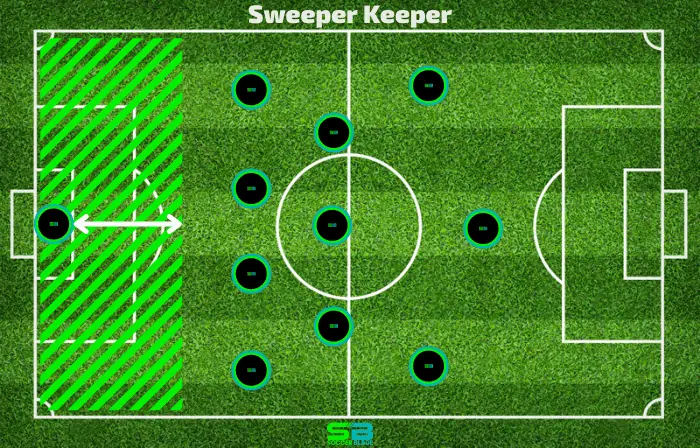
In modern soccer, goalkeepers are often skilled enough in possession that they act as sweepers. Ederson (Manchester City) is a great example of this.
See the sweeper-keeper Ederson and the role of a sweeper;
#6 + #8 Center-Midfield (CM)
Center-midfielders (CMs) are positioned in the middle of the field but tend to cover a huge amount of ground, finding themselves in attacking and defensive positions.
They gain possession of the ball frequently and make a lot of passes. CMs have defensive and offensive duties, but their roles can be vastly different.
Some MFs are the main architects of attack, while others aim to break up the opposition at every opportunity.
Midfielders’ Position, Role and Responsibilities
In the modern game, midfielders are populated by specialist-type players, with either attacking or defensive characteristics.
The classic 4-4-2 formation usually held a midfield pairing of two ‘all-round’ players. Although, there are a few variations of this role:
Attacking-Midfield (AM)
A purely attacking midfield player would not be very common in a 4-4-2 formation. The #10 is the player who’d fulfill this role.
An attacking MF would be more common in a diamond-shaped midfield. See the #10 role below for more detail on this position.
Defensive-Midfield (DM)
Typically, the defense-minded midfielder would wear the #4 or #6 (depending on what number the defender is wearing).
This player sits in front of and protects the back 4 (defenders). Many defensive midfielders are deployed as ‘hatchet-men’.
They’re rough and tumble tough guys with limited skill, but work tremendously hard for their team. Hard work ethic and aggressiveness are the main ingredients in these players.
Their role is to put in hard tackles, break up attacks, and boss the midfield from a defensive standpoint. In other cases, a quality defensive midfielder is a difficult specialized position.
The best-in-class defensive MFs are some of the most sought-after players in today’s game. They’re astute tactical players with an exceptional talent for reading the game.
Their main roles are marking, tackling, intercepting, and passing. Defensive MFs must be very disciplined and play with a high soccer IQ.
Two of the best examples of defensive MFs in the world currently play for Barcelona: Sergio Busquets and Frenkie de Jong;
Frenkie De Jong
Box-to-Box Midfielder (CM)
The term box-to-box is a sought-after player that’s highly capable of passing, tackling, and shooting, with the drive and determination to cover the length of the field when needed.
These players work from box to box, defending as well as attacking. The ‘all-rounders’ are a traditional-style MF player.
They’re not very specialized but are competent in a multitude of areas. The player style can be observed in the modern game but the ‘greats’ of this position date to the 90s and early 2000s.
Stamina is a core characteristic of a box-to-box MF player; they lead by example on the field. They can be invaluable to a team and bring great balance to a starting 11.
Some of the best box-to-box midfielders since the 90s are N’golo Kante, Steven Gerrard, Frank Lampard, Roy Keane, Bastian Schweinsteiger, and Arturo Vidal.
#7 Right-Midfield – #11 Left-Midfield / Winger (RM-LM/RW-LW)
Right, and left midfielders are also known as wingers. They occupy space near either touchline. For many teams, wingers play a significant role in their offensive gameplay.
Wingers are usually quick and skilled with the ball at their feet.
They rely on their ability to beat a player 1 V 1 to give themselves opportunities to cross the ball or create a goalscoring chance.
A lot of wingers are quality strikers of the ball with the vision and ability to pick out their strikers with crosses or passes from wide areas.
Great wide midfielders tend to chip in with their fair share of goals and assists.
Wide Midfielders’ Position, Role and Responsibilities
They’ve defensive duties too. Failure to track runs from opposition FBs can lead to goal chances. If a team has a particularly dangerous wide midfielder.
We frequently see the opposition winger being disciplined defensively, doubling up with his/her FB to minimize the threat.
Traditionally, left-sided midfielders were left-footed, while right-sided midfielders were right-footed.
This would make it easier to beat their defenders on the outside and play effective crosses using their strong foot.
These days it’s more common to see ‘inverted wingers’ – those who play on their ‘weaker side’, cutting inside rather than playing wide in the channel.
Crossing from wide areas is less common today, so inverted wingers tend to link up with their strikers, cut in and shoot from the wing, or make sharp runs into the penalty area.
A popular formation currently is a 4-3-3, with 2 wide forward players.
The wingers in this formation are far more attack-minded than traditional ones and often have minimal defensive duties in their own half.
Although, these players are usually key to a high press – a staple of the modern game. Examples of inverted wingers are Gareth Bale, Arjen Robben, Frank Ribery, Eden Hazard, and Megan Rapinoe.
Here are some highlights of Bale and Robben;
#9 Center-Forward – Striker (CF-ST)
The center forward is usually the main goalscorer in a team, particularly in a 4-4-2 set-up where they play behind a second striker or attacking midfielder. The role of a CF has never been one-dimensional.
Certain body types, physical attributes, and playing styles suit different roles. Some CFs like to receive the ball with their back to goal, allowing them to hold up possession with a view to turning their defender or linking up with a teammate.
Others prefer to play on the shoulder of a defender, making runs in behind the defense at every opportunity.
‘Target men’ are usually tall, physical players who thrive on crosses into the box and duels with defenders. The elite center-forward can fulfill several of these roles.
Zlatan Ibrahimovic and Wayne Rooney are great examples of this. They can switch up their playing style, depending on what will be most effective.
In some formations, we see players operating as a ‘false 9’, where they appear as the main striker but actually operate as a playmaking number 10.
Robert Firmino, of Liverpool, is currently the most notable and effective false 9 in the game.
Two different strikers but effective – Firminio and Ibrahimovic;
#10 Second Striker / Center-Forward / Attacking Midfield (ST-CF-AM)
Playing between the lines of the opposition midfield and defense, this player is expected to create and provide meaningful supply to his/her team’s attack.
This may come in the form of a penetrating pass that sets a striker through on goal, it may come as a dribble that beats a player and sets up a scoring chance, or it may come in the form of a goal itself.
Attacking MFs are seen as playmakers. They’ve good mobility and balance and provide skill and creativity.
They must have a quality first touch and play with awareness and vision.
The ability to execute in the final third separates the best from the rest. In some teams, the #10 operates as a second striker or center-forward and plays alongside their #9 teammate.
Modern Soccer Numbering Systems
Nowadays, a player’s squad number does not necessarily signify their position. However, the original numbering system remains relevant as players, coaches, and pundits speak about positions.
This is about the numbers that they were traditionally assigned. We often hear pundits argue whether a striker’s best position is as a #9 or a #10.
The most popular and sought-after squad numbers still fall within the original 11.
If a player wears a squad number from 1-11, it’ll usually indicate their position somewhat.
There are always exceptions, however. Samuel Eto’o, the striker, famously wore the #5 for Everton in the 14/15 season.
Can a soccer player pick a Jersey number?
A modern number system, particularly at the team level, does not represent a player’s position. A squad number now holds commercial value. It can become part of a player’s brand or identity on and off the field.
Players often demand a particular squad number when they’re transferred to a new team. A strong association between a player and a squad number can lead to significant uniform and merchandise sales for a franchise.
We’re in an era where player power is at an all-time high. Image rights are extremely valuable when negotiating wages. A recognizable squad number can play a huge role in this.
Who would have known the significance that squad numbers would have on the game of soccer when Arsenal and Sheffield first wore them in 1928?
soccer Numbering Related Questions
Is it mandatory to wear a squad number?
Yes. All players must be registered for a competition and assigned a squad number by their franchise.
Are soccer numbering systems used around the world?
At the national and international levels, the standard numbering system is used. Perhaps at the amateur level, there are exceptions to this.
What soccer numbers can players wear on their jerseys?
Squad numbers are from 1 to 99.
Share the post "Soccer Position Numbers (Each Explained)"
Joel is a seasoned soccer journalist and analyst with many years of experience in the field. Joel specializes in game analysis, player profiles, transfer news, and has a keen eye for the tactical nuances of the game. He played at various levels in the game and coached teams - he is happy to share his insight with you.



